1.什么是jsp的属性范围?
所谓的属性范围就是一个属性设置之后,可以经过多少个其他页面后仍然可以保存并继续使用。jsp提供了四种属性范围,如下:
- 当前页,对应的jsp对象为pageContext,属性的作用范围仅限于当前JSP页面,跳转到其他页面无法取得。
- 一次服务请求,对应的jsp对象为request,属性的作用范围仅限于同一个请求。
- 一次会话(浏览器打开到关闭为一次会话),对应的jsp对象为session,一个用户设置的内容,只要是与此用户相关的页面都可以访问。
- 上下文,对应的jsp对象为application,属性的作用范围限于当前web应用,是范围最大的属性作用范围,只要在一处设置属性,在其他各处的JSP或Servlet中都可以获取到。
2.属性的操作方法
public void setAttribute(String name,Object value) 设置属性
public object getAttribute(String name) 取得属性
public void removeAttribute(String name) 删除属性
示例代码如下:
<%@ page language="java" import="java.util.*" pageEncoding="UTF-8"%>
<%
String path = request.getContextPath();
String basePath = request.getScheme()+"://"+request.getServerName()+":"+request.getServerPort()+path+"/";
%>
<!DOCTYPE HTML PUBLIC "-//W3C//DTD HTML 4.01 Transitional//EN">
<html>
<head>
<base href="<%=basePath%>">
<title>My JSP 'attrTest1.jsp' starting page</title>
<meta http-equiv="pragma" content="no-cache">
<meta http-equiv="cache-control" content="no-cache">
<meta http-equiv="expires" content="0">
<meta http-equiv="keywords" content="keyword1,keyword2,keyword3">
<meta http-equiv="description" content="This is my page">
<!--
<link rel="stylesheet" type="text/css" href="styles.css">
-->
</head>
<body>
<%
pageContext.setAttribute("pageContextAttr", "pageContextValue");
request.setAttribute("requestAttr", "requestValue");
session.setAttribute("sessionAttr", "sessionValue");
application.setAttribute("applicationAttr", "applicationValue");
%>
<br><br>
pageContextAttr: <%=pageContext.getAttribute("pageContextAttr") %>
<br><br>
request: <%=request.getAttribute("requestAttr") %>
<br><br>
session: <%=session.getAttribute("sessionAttr") %>
<br><br>
application: <%=application.getAttribute("applicationAttr") %>
</body>
</html>
运行后输出结果如下:
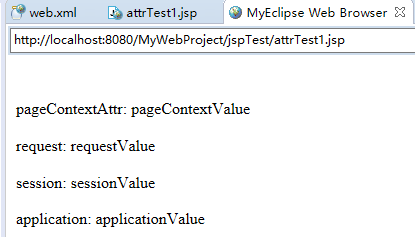
3.四种属性范围的具体介绍
示例代码如下:
attrTest1.jsp
<%@ page language="java" import="java.util.*" pageEncoding="UTF-8"%>
<%
String path = request.getContextPath();
String basePath = request.getScheme()+"://"+request.getServerName()+":"+request.getServerPort()+path+"/";
%>
<!DOCTYPE HTML PUBLIC "-//W3C//DTD HTML 4.01 Transitional//EN">
<html>
<head>
<base href="<%=basePath%>">
<title>My JSP 'attrTest1.jsp' starting page</title>
<meta http-equiv="pragma" content="no-cache">
<meta http-equiv="cache-control" content="no-cache">
<meta http-equiv="expires" content="0">
<meta http-equiv="keywords" content="keyword1,keyword2,keyword3">
<meta http-equiv="description" content="This is my page">
<!--
<link rel="stylesheet" type="text/css" href="styles.css">
-->
</head>
<body>
<%
pageContext.setAttribute("pageContextAttr", "pageContextValue");
request.setAttribute("requestAttr", "requestValue");
session.setAttribute("sessionAttr", "sessionValue");
application.setAttribute("applicationAttr", "applicationValue");
%>
<h2>attrTest1 page</h2>
<br>
pageContextAttr: <%=pageContext.getAttribute("pageContextAttr") %>
<br><br>
request: <%=request.getAttribute("requestAttr") %>
<br><br>
session: <%=session.getAttribute("sessionAttr") %>
<br><br>
application: <%=application.getAttribute("applicationAttr") %>
<br><br>
<a href="jspTest/attrTest2.jsp">To attrTest2 Page</a>
</body>
</html>
attrTest2.jsp
<%@ page language="java" import="java.util.*" pageEncoding="UTF-8"%>
<%
String path = request.getContextPath();
String basePath = request.getScheme()+"://"+request.getServerName()+":"+request.getServerPort()+path+"/";
%>
<!DOCTYPE HTML PUBLIC "-//W3C//DTD HTML 4.01 Transitional//EN">
<html>
<head>
<base href="<%=basePath%>">
<title>My JSP 'attrTest2.jsp' starting page</title>
<meta http-equiv="pragma" content="no-cache">
<meta http-equiv="cache-control" content="no-cache">
<meta http-equiv="expires" content="0">
<meta http-equiv="keywords" content="keyword1,keyword2,keyword3">
<meta http-equiv="description" content="This is my page">
<!--
<link rel="stylesheet" type="text/css" href="styles.css">
-->
</head>
<body>
<h2>attrTest2 page</h2>
<br>
pageContextAttr: <%=pageContext.getAttribute("pageContextAttr") %>
<br><br>
request: <%=request.getAttribute("requestAttr") %>
<br><br>
session: <%=session.getAttribute("sessionAttr") %>
<br><br>
application: <%=application.getAttribute("applicationAttr") %>
<br><br>
</body>
</html>
运行后跳转页面显示结果如下:

从上面的运行结果来看,pageContext属性的作用范围仅限于当前JSP页面,从attrTest1页面跳转到attrTest2页面之后,pageContext对象获得的属性值为null。
修改上面的代码:
attrTest1.jsp中,做如下修改:
<h2>attrTest1 page: <%=new Date() %></h2>
attrTest2.jsp中,做如下修改:
<h2>attrTest2 page:<%=new Date() %></h2>
运行attrTest1.jsp后:
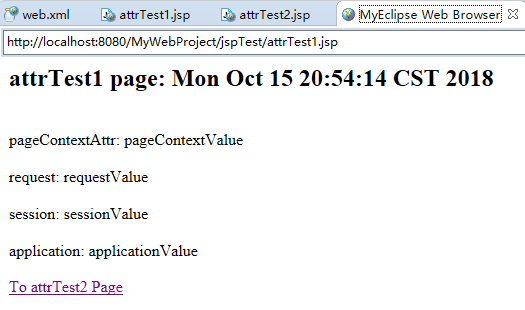
跳转到attrTest2页面:
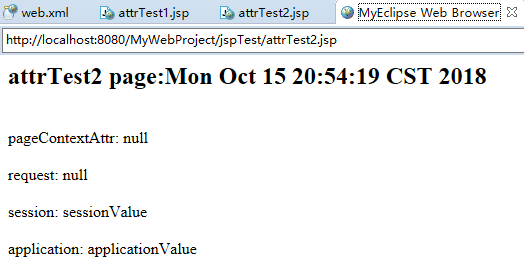
从上面的运行结果可以看出,request的属性作用范围仅限于同一个请求,对于不同页面的不同请求的Date函数的调用,输出的时间是不同的。
运行attrTest1.jsp:
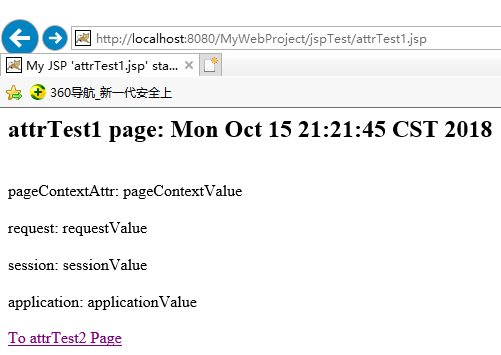
跳转到attrTest2 页面时:
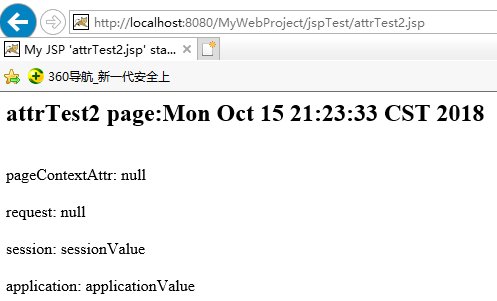
关闭浏览器,直接运行attrTest2.jsp,看到session的属性值为null,运行结果显示如下:
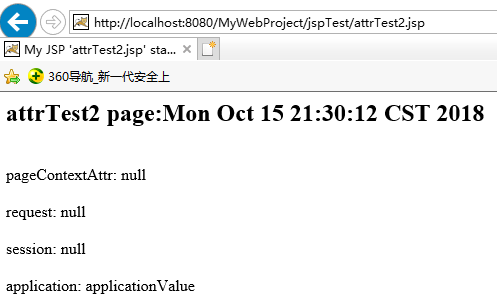
从上面的运行结果可以看出,在一次会话(session)过程中,在第一个页面上设置的属性,跳转(服务器跳转/客户端跳转)到其他页面之后,其他的页面依然可以取得第一个页面上设置的属性。会话结束后,属性值丢失(体现为session值为null)。